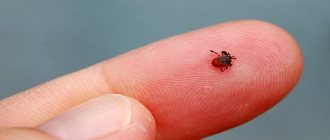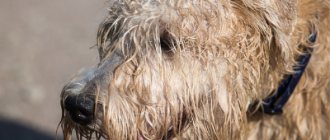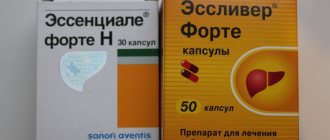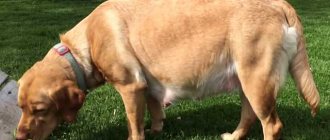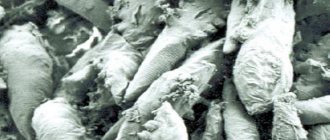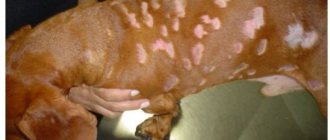Focal inflammation of the sebaceous gland and hair follicle of a purulent nature in domestic animals is called a boil. The causative agent of the infection is staphylococcus aureus and white staphylococci, which are classified as opportunistic microorganisms. A furuncle in a dog is a cone-shaped prominence above the skin, firm to the touch and painful for the pet.
The inflammatory process often ends with spontaneous opening, which leads to infection of healthy tissue.
Abscess concept
An abscess in dogs is an inflammatory process that occurs in the skin, which is accompanied by the formation and accumulation of purulent formations due to necrosis (rotting) of tissue. A bag of pus, pieces of necrotic tissue and pathogenic microflora forms under the skin. Around the sac, the tissue becomes inflamed and the walls of an abscess begin to form, which consists of a surface layer formed by fibrous connective tissue and an internal, pyogenic layer of granulation tissue. If no measures are taken, the bag will grow and bother the animal. In addition to being painful, abscesses negatively affect the overall health of your pet.
The disease can be localized in any part of the body due to mechanical damage: bruises, injuries and injections. And if there are malfunctions in the functioning of the secretory organs, then an abscess of the gland may develop in the dog.
When the paraanal gland becomes inflamed, the excretory canal is blocked and the secretion accumulates inside. Finding no way out, the fluid overflows the gland, and the wall and skin rupture. This is an abscess that resembles an ulcer.
Consequences for the animal
Despite the apparent ease of the problem, furunculosis causes serious suffering to the animal. Long-term intoxication of the body with products of purulent inflammation often leads to impaired renal function. Complication of the inflammatory process by secondary infection increases the risk of developing a generalized form and even sepsis, which is life-threatening for the dog.
Due to the possibility of complications, the owner should carefully monitor the condition of the skin of their four-legged friend and promptly seek qualified help.
Causes of abscess
The occurrence of an abscess is associated with the penetration of pathogenic microorganisms into tissues through wounds and abrasions. Also, such a reaction can be provoked by toxic substances that get under the skin. Often, an abscess in dogs forms when a purulent process begins in hematomas and lymphatic drainages, as well as when microorganisms are transferred by the bloodstream from the source of suppuration.
This disease is quite common among four-legged pets. According to statistics, every second dog suffers from an abscess, but the reasons for its occurrence vary:
- injections;
- abrasions, scratches, injuries, bruises;
- wound contamination;
- lack of hygiene procedures or lack thereof;
- microbes and bacteria;
- improper care.
Before starting treatment, it is necessary to determine the nature of the abscess and establish the degree and form of the disease.
Claws
Claws (nail, toenail, claw) are beak-shaped horny protrusions of the third phalanx of fingers.
Claws can be strong, weak, sharpened, or overgrown. The claws vary in color from light to black. Some standards only require dark claws.
Nails grow quite quickly and, if they are not naturally rubbed off on a hard surface or trimmed, they can affect the shape of the dog’s paw and movements. Sometimes long, curved nails can grow into the pads of the paws (especially on the 5th toes) and cause pain to the dog.
Types and forms of abscesses
In veterinary medicine, there are several criteria by which abscesses are classified.
Morphological composition of purulent formations and bacteria provoking the process:
- benign;
- malignant.
Clinical manifestations:
- hot or spicy;
- cold, or chronic.
Location of the lesion:
- superficial, which develops in the skin and subcutaneous tissues;
- deep, which can be subfascial, intermuscular, intramuscular, subperiosteal, bone, subperitoneal, abscess of organs and glands, depending on the location.
With a benign abscess, thick, creamy, purulent accumulations are formed, with an increased content of leukocytes, without microbes or with little presence of them. A benign abscess can form if low-virulent staphylococci penetrate the tissue or when irritating substances are introduced under the skin. This often occurs in dogs.
In a malignant abscess, the purulent formations are watery and thin, with a high concentration of pathogens and low production of white blood cells. The causative agents of the malignant process are purulent-putrefactive and anaerobic microbes. This type of abscess in dogs is more painful and will not go away on its own. It can develop into a more complex form and affect adjacent tissues. Such formations require surgical intervention; in other words, they are removed through surgery.
With a hot abscess, a pronounced inflammatory process is observed, which is characterized by an acute course and the rapid formation of an abscess, which often opens spontaneously, that is, it breaks through and the pus flows out.
With a cold abscess, the main signs of inflammation are weak, and pus accumulates slowly, which makes timely diagnosis difficult. Such abscesses are typical of old and emaciated dogs that move little. An abscess is formed in the presence of low-virulent microorganisms.
How to recognize the disease
An abscess in a dog, the photo of which is presented in this article, can be determined visually if the symptoms are severe, but in some cases it cannot be done without special examinations. Symptoms differ for different inflammatory processes.
Symptoms of a benign abscess:
- swelling with clear edges;
- redness;
- pain when touched.
Symptoms of malignancy:
- formation of a soft tubercle;
- increased body temperature of the animal;
- severe pain when pressed.
An abscess of a dog’s paraanal glands not only gives external symptoms, but also affects the general condition of the pet’s body. Observed:
- lethargy;
- gloominess;
- increased body temperature;
- lack of appetite;
- apathy and indifference to walks;
- the anal area becomes inflamed;
- purulent ulcers form;
- there is pain in the adjacent tissues.
You should not try to clean the wound yourself, so as not to harm the animal. You should immediately contact a specialist.
If the symptoms do not indicate a specific type of abscess, and the pet’s condition worsens, then you should immediately contact the veterinary clinic. Timely diagnosis and proper treatment will help avoid complications.
Sterile interdigital furunculosis in dogs
Diagnosis Treatment
The origin of a disease such as sterile interdigital furunculosis in dogs is still not clear. According to some hypotheses, the occurrence of this disease is an inflammatory response to triglycerides and keratin, which enter the skin from destroyed hair follicles, subcutaneous tissue, and sebaceous glands. It is also assumed that this condition continues to develop even after the original cause of the disease ends. It is worth noting that representatives of breeds with short hair are most prone to this disease.
The disease can be localized on either a single or several limbs. This disease manifests itself in the form of multiple or single papules, dense nodules or formations. It is often located in the area between the fingers, accompanied by itching and pain, and sometimes by the formation of ulcers and fistulas, with purulent discharge. In advanced cases, tissue fibrosis develops. Lesions can disappear as spontaneously as they appeared; they are characterized by intensification and attenuation of the manifestations of the disease. The disease may be complicated by the development of secondary infections.
Sometimes interdigital furunculosis in short-haired dogs can be caused by atopic dermatitis. Also, the cause of this disease can be “ingrown” hairs between the fingers of animals.
Brachydactyly
Brachydactyly is shortening of the outer toes of the front and sometimes hind paws. Caused by the absence or underdevelopment of the phalanges of the fingers. There are several types of brachydactyly in dogs:
- brachydactyly type A1 - a rudimentary structure of the middle phalanges is observed, in some cases there is a fusion of the phalanges with the terminal phalanges. Shortening of the proximal phalanges of the first toes and hands, growth retardation may occur;
- brachydactyly type A2 is marked by the presence of shortening of the middle phalanges of the second fingers of the hands, the remaining fingers are relatively preserved;
- brachydactyly type A3 – characterized by shortening and radial curvature of the middle fifth fingers of the hands;
- Brachydactyly type B is marked not only by a decrease in the length of the middle phalanges, but also by underdevelopment or complete absence of the terminal phalanges. Fusion of the second and third fingers is observed;
- Brachydactyly type C is characterized by shortening of the proximal and middle phalanges of the second and third fingers. Fusion of the phalanges and shortening of the metacarpal bones are observed;
- brachydactyly type D is diagnosed if there is shortening of the first fingers of the hands;
- brachydactyly type E – shortening of the metacarpal and metatarsal bones is observed.
Brachydactyly in the Mexican Hairless Dog
Diagnostic methods
Abscesses have much in common with hematomas, hernias and tumors, but the symptoms and contents of the formations are different. Therefore, in order to establish an accurate diagnosis and prescribe the correct treatment, the doctor conducts an examination and prescribes a number of examinations:
- the course of the disease is studied;
- the abscess is examined and palpated;
- a puncture is performed to study the contents;
- compare the temperature of the affected area and healthy tissue.
If necessary, an MRI or ultrasound may be prescribed. This is especially true for internal formations.
Causes of pododermatitis in dogs
Pododermatitis (or pyoderma) is an inflammatory process on the paws of a pet. The pathology is considered difficult for medical diagnosis. In fact, it is not a separate disease, like a cold, but a sign of a number of diseases, like a high fever or a runny nose. In order to correctly prescribe treatment, the doctor must accurately determine which tissues are affected and by what exactly.
There are many reasons for the occurrence of pathology:
| Localization | Probable Cause |
| The wound is only in one place |
|
| Multiple lesions |
|
To understand how to avoid the disease or choose a treatment method if it appears, you need to get to know the causes in more detail. After all, the underlying disease needs to be eliminated, and only then its manifestations will disappear.
Did you know? If your dog's paws smell like chips, it doesn't mean he ate them. This is the smell of bacteria that settle on the skin of pets whose paws have not been washed for a long time.
Mechanical damage
Foreign bodies penetrate the skin of the paws when the pet runs around the area. The body tries to destroy such an object by attacking it. This is how the inflammatory process begins, followed by suppuration if the thorn is not removed immediately. The damaged finger swells, the pet tries to reduce the discomfort and begins to chew it.
It is quite possible that he will remove the object himself, but he may introduce an infection from the teeth into the wound. Don't wait for this to happen and just help him get rid of the problem. If the surface of the skin is burned, it is washed with water. And then they use anti-inflammatory antibacterial ointments - “Tetracycline” or “Ichthyol”.
Infections
Deep paw infections that are caused by bacteria or fungi are common in dogs. They get inside through the wound surface resulting from a cut with a sharp object.
This causes inflammation and is accompanied by:
- swelling;
- increased temperature;
- suppuration;
- lameness.
To avoid such a development of events, paws after a walk should be washed and inspected for damage. For washing, take a special paw washer. This is a glass with polymer bristles on the inner surface. Fill with water and detergent, put your paw in it and rotate the glass. The result is well-cleaned paws.
Did you know? The microflora of the human body is represented by 40 trillion different bacteria and microorganisms, while the body itself is formed by only 30 trillion cells.
If you notice a wound, it needs to be treated with an antiseptic. Choose Chlorhexidine, Mirastimin, Percutan or hydrogen peroxide - all of them are designed to disinfect the wound surface. Apply the product to a cotton pad and wipe the damaged area. Antibiotics are used to stop the inflammatory infectious process. Lubricate the paw with “Ichthyol ointment” or “Levomekol”. Do this at least 3 times a day until the signs of the problem disappear.
Parasites
The Demodex mite not only parasitizes the skin, but can also cause pododermatitis in dogs. It is believed that mites are constantly present on the skin in small quantities.
But when the immune system is weakened, they begin to actively multiply, which leads to:
- hair loss;
- swelling;
- constant itching;
- bleeding wounds.
Mites live in hair follicles. When one hair follicle is eaten, the parasite gnaws its way through the skin to the next, causing the dog a lot of unpleasant sensations. The tunnels made by mites become colonized with bacteria and inflammation develops. Treatment for Demodex Canis involves several medications and is prescribed by a veterinarian.
The list includes:
- anti-tick drug - “Ivermectin” 1% at a dosage of 0.1 ml per 5 kg of animal weight once, intramuscularly;
- antiseptic for treating the wound surface - “Ichthyol ointment” is applied to the skin every 8 hours;
- immunomodulator - “Immunofan”, “Hemobalance” or “Fosprenil”;
- to reduce the load on the kidneys - “Hepatovet”, “Karsil”.
An antibiotic may also be prescribed if there is a bacterial infection.
Important! Ivermectin is contraindicated in representatives of the Sheltie, Collie, and Bobtail breeds due to breed intolerance. It is also not prescribed to puppies under 6 months and pregnant or lactating bitches.
Allergy
Allergic pathologies very often lead to inflammation of the skin of the legs. The most common causes of allergic pododermatitis in dogs are food and environmental allergens - pollen, dust mites. But such allergies begin between the ages of 6 months and 3 years. Therefore, if your dog is older, then most likely the cause of pododermatitis on its paws is definitely not allergic.
How to treat the disease
Treatment of the disease is carried out using different methods. The veterinarian should prescribe a course of general and local therapy or recommend surgery.
If a benign abscess is diagnosed in a dog, treatment is carried out with medication, which consists of:
- absorbable ointments used to treat unruptured formations;
- antiseptic solutions for treating wounds in spontaneous cases;
- antiseptic ointments that are applied to the wound channels.
The affected area should be washed with a syringe so as not to cause unnecessary inconvenience to the pet.
When a malignant abscess is diagnosed, surgery is prescribed to remove the purulent sac. Manipulation should be carried out as quickly as possible, before the disease spreads to adjacent tissues. In the postoperative period, general and local therapy and a course of antibiotics are carried out.
If the paraanal glands are affected, treatment should be carried out in a clinical setting. After examination and determination of the extent of the problem, drug treatment in combination with warm compresses will be prescribed. In more serious cases, the veterinarian will open and treat the abscess himself. Often, additional drainage is required to remove pus. Afterwards, treatment with strong antibiotics is prescribed to suppress pathogenic microflora, using rectal suppositories and local treatments.
Diagnosis and treatment of furunculosis in dogs
Diagnosis of the disease in dogs includes examination of the animal to determine the location of foci of inflammation and the severity of furunculosis.
To clarify the cause and assess the general condition of the pet, laboratory tests of urine and feces are performed in the clinic.
Treatment at home is unacceptable; improper opening of an immature boil is fraught with the formation of new foci of suppuration and sepsis.
Therapy includes general measures aimed at stopping the development of pathogenic microflora and increasing the body's overall resistance, and local treatment of the source of inflammation.
The dog is given rest, increased nutrition with the use of vitamin and mineral supplements, and water procedures are excluded during the recovery period.
Local treatment includes:
- hygiene of the affected area;
- alcohol dressings and ointment compresses that accelerate the maturation of the boil;
- novocaine blockades for pain relief at the source of inflammation;
- surgical opening of a mature boil using local anesthesia;
- postoperative wound treatment.
To exclude new skin lesions, the animal is prescribed courses of antibiotics, immunostimulants and vitamins.
Preventive actions
By following a number of simple rules, you can protect your pet from the disease and prevent the formation of purulent lumps. These include:
- maintaining careful hygiene;
- regular inspections of the animal for damage;
- treatment of even minor wounds;
- ensuring proper care of the animal;
- regular veterinary examinations.
Abscesses cannot be ignored to prevent complications. An abscess can form in a short time and grows rapidly, affecting and destroying healthy tissue, and there is also an intensive proliferation of microbes that can infect the entire body of the animal.
Staphylococcus aureus and white are bacteria that live on the body, in any room, on the street, on all surfaces, clothing, personal belongings, and even in hospital wards. The bacterium is relatively safe and cannot cause harm to an organism with a strong immune system. But with a decrease in immune defense, staphylococci cause a number of diseases, and a boil in a dog is no exception.
Incredible! The conditionally safe bacterium staphylococcus can kill a person with a low level of immunity.
Furunculosis is a full-fledged bacterial disease, accompanied by purulent inflammation of the sebaceous gland and hair follicle. Infection occurs through contact, the main reason being skin contamination and low immunity. Given activity and regular walks, boils most often occur on the dog’s front legs, more precisely, between the pads or pads (the skin is constantly injured by the road surface).
Important! Furunculosis occurs due to infection by staphylococci, but it is useless to treat the dog “in a circle” by eliminating the bacteria with antibiotics! We need to find and stop the root cause.
A boil on a dog’s back most often occurs as a consequence of a deviation in the functioning of the sebaceous glands. Inflammations on the face, chin, and behind the ears occur when scratching; possible causes are skin diseases and allergies. Areas of the body that are not protected by fur quickly become dirty due to the mixing of sebum and dust - the main cause of inflammation in the abdomen. We can continue to list the “reasons,” but the reason always lies in weak immune defense, because bacteria live on healthy dogs without causing harm.
Prevention
In order to prevent the development of furunculosis in dogs, veterinary experts recommend that owners adhere to the following rules and advice:
- Keep the animal in proper sanitary conditions.
- After a walk, remove dirt from the pet’s coat and limbs.
- Regularly clean the coat, fight tangles, and bathe the dog using special shampoos.
- Monitor the state of the animal's immune system. Strengthen your pet’s body with multivitamin complexes after preliminary consultation with a veterinarian.
We recommend reading about gangrene in dogs. You will learn about the causes of gangrene, types of gangrene in dogs and their characteristics, drug and surgical treatment, and prevention of development. And here is more information about a purulent wound in a dog.
The formation of boils on a dog’s body is not such a rare occurrence. As a rule, animals with a low level of immune defense suffer from the disease. Skin hygiene and the hormonal status of the body play an important role in the development of inflammation.
Treatment should be comprehensive and include the use of both local anti-inflammatory drugs and systemic use of antibiotics. Often, the veterinarian resorts to surgical opening of the abscess.
What does a boil look like, stages and forms of progression?
Inflammation begins when bacteria enter a skin pore. In the sac with the hair follicle, the bacterium begins to actively multiply, causing inflammation that affects the sebaceous gland and adjacent “loose” skin tissue. The course of the disease is divided into the following stages:
- Initial
– redness, increased local temperature, swelling. The skin is thick and tense.
- Progressive
- the inflamed area clearly increases, pain appears - see photo. Lameness is observed if there is a boil on the dog’s paw, it is difficult for the animal to sit or run, or there is inflammation on the buttocks or armpits. Most often, furunculosis is diagnosed at a progressive stage, the problem is solved with a simple operation.
- Acute
– the dog’s temperature rises, malaise and weakness occur. If the boil is on the stomach or other area without fur, pus can be seen under the skin.
Depending on the general health of the pet and breed predisposition, three forms of furunculosis can be observed:
- Local
– inflammation is limited to a single boil and is irreversibly cured with the right approach. Before treating a boil yourself, keep in mind that a small incision under local anesthesia will solve the problem instantly, while “natural” maturation will take a long period.
- Localized
- in one area of the skin (face, paw, abdomen, armpits) several foci of inflammation are observed at once. Requires extensive diagnostics and identification of root causes.
- General
– most often, chronic form. Boils appear with indefinite frequency on different parts of the body. Treatment includes complex supportive therapy and opening of mature boils. It is highly not recommended to treat it yourself - it is useless.
A dog is man's friend, and we are ready to do anything to protect it. But no matter how hard we try to protect our pet, it is not protected from the dangers that await it at every step.
Any walk with your four-legged pet in the fresh air can be fatal for him. And one of these dangers is an abscess. According to statistics, every second dog develops an abscess at least once in its life. Its cause can be any physical damage to the skin, a bite from another dog, a cut on any object, getting a splinter, negligence when administering various medications, etc. Pyogenic microbes (pseudomonas aeruginosa, streptococci, staphylococci, etc.) will penetrate through the wound. which will cause an abscess to form. And to help a pet, we must be prepared.
An abscess is an abscess that can be of 2 types: superficial and deep.
Superficial is located on any easily visible part of the body, it can be quickly detected and action taken. Deep, in turn, occurs on internal organs and under the mucous membranes, which complicates the task of detecting it.
There are also 4 types of abscess:
1) Benign
look like reddened swellings with walls. They contain thick pus, which contains low-virulent staphylococci and a large number of living leukocytes.
2) Malignant
similar to a tubercle that is not very noticeable. They are not elastic, as if filled with water, and are more painful than benign ones. They contain liquid pus, anaerobes and putrefactive bacteria.
3) "Hot"
the abscess is very pronounced on the dog’s body: red, swollen, painful, with a high temperature at the site of damage. It forms quite quickly and is acute, and can open on its own.
4) "Cold"
, on the contrary, it develops slowly, all signs appear rather weakly. It does not resolve on its own, so it is advisable to immediately contact a veterinarian. Most often, this type manifests itself in old sick dogs with reduced infectious defenses of the body.
Treatment of abscess in dogs
Depending on the type of disease, therapeutic measures differ:
- If the formation is benign, bandages are applied to the stomach and other damaged areas with Vishnevsky ointment, agave leaf, and ichthyol ointment. If the wound bursts on its own, you need to apply 3% hydrogen peroxide or an antiseptic solution. Owners should not try to open an abscess, because the infection will spread throughout the body. To wash it, you should insert the syringe far into the abscess.
- If the tumor is malignant, you should immediately contact a medical facility and follow the recommendations of a veterinarian. Antibiotics may be administered to eliminate the infection. If surgical intervention is required, the doctor proceeds as follows: treats the wound with antibacterial agents, removes dead tissue, installs a device with which the pus can easily flow out within several days, and applies a bandage. It needs to be changed every day, and the pet should also be given vitamins and antibiotics on the recommendation of a specialist. In case of odontogenic type of disease, the tooth is removed and the abscess is drained.
Many people are interested in the question of how much it costs to open an abscess. On average in Moscow after the operation you will need to pay 700 rubles.
On the paw, between the toes
An abscess can be successfully eliminated at home using traditional methods and homeopathic medicines if it is small in size and does not cause severe pain to the pet. For this purpose, use warm compresses with infusion of celandine or plantain. Fold the bandage, dip it in the product, and hold it on the paw for ten minutes. Repeat the procedure several times a day.
The wound is treated with a solution of St. John's wort and calendula. Bring 250 ml of water to a boil, wait to cool. Pour in ten drops of the tincture of each plant, add a quarter teaspoon of table salt. Using a syringe, carefully rinse the wound. Actions should be repeated 3-4 times a day until noticeable improvement (wound healing).
During therapy, it is important to ensure that the dog does not lick or bite the formation. If this is observed constantly, it is worth using a special collar, which will protect the pet’s face from the affected area.
Paraanal gland
With this pathology, the dog moves its butt on the floor, and some animals even have watery eyes. The owner may see a red or blue formation under the tail near the anus. The dog does not want to go outside, he loses his appetite. Sometimes the temperature increases. This disease requires immediate medical attention. The specialist will open the abscess, treat the wound, install a special device and apply a bandage.
On the neck
An abscess on the neck or face can also be treated at home. At the same time, it is important to pay attention to the pet’s condition and go to the doctor if there is no improvement. It is important to strengthen the dog's immunity, for example, with echinacea. Make a tincture and give an adult 5 drops 2-3 times a day. Vitamin C will also be effective.
Prostate
Prostate abscess is the most severe form of bacterial prostatitis. It is most often seen in aging pets over the age of seven. The most effective method of treatment in this case is castration. After this, the disease goes away within seven days. If it is necessary to preserve reproductive ability, antiandrogenic drugs, progestogens, etc. are prescribed.
Dewclaws
The vestigial (dewclaw) finger is considered to be the first toe on the hind paw, although sometimes this term is also applied to the first toes on the forelimbs. The vestigial toe on the hind limbs is absent in most dogs. E. Wiesner and Z. Wheeler (1979) suggest that the formation of dewclaws in dogs represents an atavism, a return to the ancestral form - the kino-dictys, which lived in the Paleocene. They are not a sign of degeneration and do not affect the quality of the offspring in any way. The appearance of dewclaws is called polydactyly. The phenomenon of polydactyly is known only in domestic dogs; it has not been found in wolves and other wild canines. Thus, the presence of wolf-dog hybrids in nature is sometimes established.
The posterior vestigial finger often lacks the first or second phalanx and is attached only to the skin. Due to this weak attachment, it is prone to injury. The anterior vestigial finger usually has three phalanges and is firmly attached to the limb.
Dewclaws are usually removed at the request of the owner in small puppies, especially in breeds that require constant grooming (poodles, schnauzers, fox terriers), show dogs whose standard clearly states its absence, or hunting dogs to prevent injury. Sometimes, after a traumatic injury, the rudimentary finger is amputated in adult dogs.
However, in the standard for some breeds, dewclaws are indicated as a mandatory feature, including double toes (Great Pyrenees, Briard, Beauceron, Icelandic Cattle Dog).
In Pharaoh dogs and some other breeds, the appearance of additional fingers on the forelimbs, visually changed, was noted. They are usually located above the main toes and look like a wart. But, if you look closely, you can see that this new growth has villi, similar to the villi on the paw pads. Sometimes such a false finger has an underdeveloped claw. Additional fingers can have either completely all the constituent elements of the phalanx of the joint, or only part of these elements.
Polydactyly in the Pharaoh Hound
Symptoms
A lump appears at the site of the damage, which becomes larger before our eyes and bursts after a few days. These are signs of a superficial abscess. But with signs of deep things, everything is much more difficult. You can only notice that the dog is sick. She is depressed, has rapid breathing, fever, and is clearly experiencing pain in some specific place. And only in a veterinary clinic with an x-ray or a blood test (acute purulent inflammation will be visible in it) can a deep abscess be determined. Sometimes a chemical abscess can occur; this happens when substances that cause non-infectious inflammation are introduced into the tissues.
Carbuncle in dogs
Carbuncle (Carbunculus).
This name refers to acute purulent inflammation of several nearby hair follicles, sebaceous glands with the loose connective tissue surrounding them. The disease is characterized by the development of a larger infiltrate than with a boil, followed by significant necrosis of the skin and subcutaneous tissue.
Etiology and pathogenesis
are the same as with a boil, but differ in the more extensive nature of their development. Due to necrosis of the skin and subcutaneous tissue, cavities and niches containing necrotic tissue are formed in the thickness of the carbuncle tissue. The demarcation barrier is poorly expressed, its formation is slow, so carbuncles can be the cause of the development of a general purulent infection (sepsis).
Clinical picture
characterized by a dense consistency, a very painful inflammatory infiltrate with the presence of several pustules. The infiltrate gradually increases, acquires a dense consistency and a purple color. A few days after the formation of the infiltrate, the skin becomes thinner and becomes necrotic in several places, followed by the release of purulent exudate. It takes on the appearance of being pierced by many holes filled with purulent-necrotic plugs. Subsequently, these holes merge, forming an ulcer. The disease is usually accompanied by purulent-resorptive fever with an increase in body temperature up to 40°C.
Treatment is the same as for phlegmon, complex with the use of local and general effects, as well as symptomatic and pathogenetic agents (see treatment of phlegmon in this article).
Causes of boils in dogs
Furunculosis is a full-fledged bacterial disease, accompanied by purulent inflammation of the sebaceous gland and hair follicle. Infection occurs through contact, the main reason being skin contamination and low immunity. Given activity and regular walks, boils most often occur on the dog’s front legs, more precisely, between the pads or pads (the skin is constantly injured by the road surface).
Important! Furunculosis occurs due to infection by staphylococci, but it is useless to treat the dog “in a circle” by eliminating the bacteria with antibiotics! We need to find and stop the root cause.
A furuncle on a dog's back most often occurs as a result of seborrhea - a deviation in the functioning of the sebaceous glands. Inflammations on the face, chin, and behind the ears occur when scratching; possible causes are skin diseases and allergies. Areas of the body that are not protected by fur quickly become dirty due to the mixing of sebum and dust - the main cause of inflammation in the abdomen. We can continue to list the “reasons,” but the reason always lies in weak immune defense, because bacteria live on healthy dogs without causing harm.
Treatment
How to cure your pet if you find an abscess?
Depending on its type, there are treatment methods. For a benign abscess, you can apply bandages with medical ointment (Vishnevsky or ichthyol), or agave leaf. If the wound bursts on its own, it is treated with 3% hydrogen peroxide or antiseptic solutions. Under no circumstances should you open the wound yourself; this will spread the infection throughout the body.
To wash the wound, you need to insert the syringe deep into the abscess.
In case of a malignant abscess, you should immediately contact a veterinarian and follow his instructions. To cleanse the body of infection, the dog can be given antibiotics. If it comes to surgery, then let's look at what the veterinarian does in order to save your four-legged friend: first, he washes the wound with special antibacterial solutions and removes all dead tissue, then installs a special device that allows the pus to escape freely for several days, applies a bandage, which we will need to change daily, and prescribes a course of antibiotics and vitamins.
It is very difficult to protect your four-legged friend from an abscess, but you can try. As we understand, an abscess occurs when infections enter the wound. This means that we must try to protect him as much as possible from receiving these wounds. When walking a dog, the most effective way to protect it is a collar. It will eliminate any possibility of unexpected damage. In order to prevent your four-legged friend from getting injured in the yard, you need to protect him by creating an enclosure in which all safe conditions for his life will be created. You can also take your dog to the veterinarian more often, which will allow foci of infection to be found and extinguished earlier.
Now we know how to save your pet from an abscess. But the dangers that await our four-legged friend do not end with an abscess. We must be prepared for anything to protect him. After all, we are responsible for those we have tamed. Therefore, pay attention to your four-legged friends, monitor their health, create favorable living conditions, feed them properly, and your friend will live a long and happy life.
Otitis. How to cure your four-legged friend? Frostbite in a dog. Signs and treatment Treating a dog’s cough Worms in a dog How to rid a dog of ticks Causes and harms of obesity in dogs
In order to recognize and identify the symptoms of your beloved pet’s disease in time, you should pay attention to all external changes in time. Every change in behavior, lethargy, lack of appetite or obvious skin changes indicate the presence of certain diseases in the dog. Treating a dog at home is extremely dangerous. In case of certain symptoms, you should seek help from a veterinary specialist. Furunculosis is one of the most common diseases in dogs. What is he? How to recognize the symptoms of the disease in time?
Furunculosis
- a disease that is bacterial in nature. Furunculosis is accompanied by purulent inflammation of the sebaceous gland and inflammation of the hair follicle in a dog. The main form of infection is considered to be pet contact and low dog immunity. Furunculosis is accompanied by the formation of boils in the dog’s body and is considered a fairly common disease.
Furuncle
– a dense swelling in the shape of a cone, very painful for the animal. With the development and growth of the boil, it matures and reaches the size of a hazelnut. If a yellow-gray spot appears at the top of the boil, it means that the core of the boil has been formed. At the base of the shaft is hair. Opening of the boil can occur spontaneously. But, in such cases, the accumulated pus comes out and affects other areas of the skin, and new boils form.
General information
What is furunculosis?
Furunculosis is a disease of bacterial origin and is characterized by the appearance of ulcers of the sebaceous glands and inflammation of the dog’s hair follicle. Mostly, dogs with poor immunity become infected with furunculosis through contact with a sick person. Boils begin to appear on the dog’s body and bother him. This disease is quite common in dogs.
What is a boil?
The boil itself looks like a dense cone-shaped swelling. Dogs react very painfully to its appearance. Once the boil occurs, it begins to develop and grow, eventually maturing and reaching the size of a ruble coin. When a yellowish spot appears on the surface of the boil, its core is formed, at the base of which is a hair. At this stage of development, the boil may open on its own, which is extremely undesirable, because then the resulting pus will come to the surface of the skin, infection will occur and new boils will appear.
Causes of boils in dogs
The main cause of furunculosis is staphylococcus. In addition, reasons may include:
- — the dog’s state of stress (for example, moving or changing owner);
- - lack of vitamins in the body;
- - low hemoglobin, against which a loss of strength may occur;
- - dirty skin;
- - sores, abrasions on the dog’s skin;
- - indigestion.
Symptoms of furunculosis
During the disease with furunculosis, the following symptoms appear:
- - swelling, dense to the touch and externally reddish in color;
- - a small knot at the base of the dog's hair;
- - the dog displays aggression or pain when in contact with the sore;
- - over time, a yellowish spot appears on the sore;
- - After some time, the boil matures and opens on its own.
Stages and forms of the inflammatory process
The inflammatory process begins immediately after the staphylococcus bacteria enters the skin pore. The bacterium actively multiplies and causes inflammation in the skin tissues. The inflammatory process occurs in the following stages:
- Initial stage
. The first stage is characterized by redness of the skin, increased body temperature of the dog, and swelling of the affected area. - Progressive stage
. Characterized by enlargement of the affected area of skin and painful sensations. If a boil forms on the paw, the dog will begin to limp; if there is a boil on the armpits or thighs, it will be difficult for her to sit and run. - Acute stage
. Increased body temperature, weakness of the animal and general malaise.
Furunculosis in dogs manifests itself in three forms. Each of which depends on the general condition of the pet and its predisposition. In the local form, a single inflammation forms. In this case, it is better to make an incision under anesthesia without waiting for the boil to mature. Several foci of the inflammatory process are observed in the localized form of furunculosis. To establish the causes, it is necessary to carry out diagnostics. The general form subsequently becomes chronic.
Inflamed boils appear on different parts of the animal's body. When the boil ripens, it is recommended to open it. You should not treat your dog on your own; it is important to seek help from a specialist.
Stages of development of furunculosis
As soon as the staphylococcus bacterium enters a skin pore, it immediately triggers the development of the inflammatory process. It multiplies quickly and provokes inflammation in the skin tissues.
This disease goes through the following stages of development:
- The initial stage is accompanied by swelling and redness of the skin at the site of the lesion and an increase in the dog’s body temperature.
- Progressive stage - accompanied by increased swelling and severe pain. If furunculosis occurs on a dog’s paw, it will be painful for her to walk and she will begin to limp; in other places she will also experience severe discomfort.
- The acute stage is accompanied by a strong increase in body temperature, the appearance of weakness in the dog and the manifestation of general malaise.
Forms of the inflammatory process
Furunculosis in dogs can occur in three forms, which depend on the dog’s health at the time of the disease.
The very first form is called local - it causes one boil. In order not to spread the disease, it is better to get rid of it immediately by making an incision under anesthesia, without waiting for the development of subsequent forms of the disease. Localized form - accompanied by the appearance of several boils. To determine the cause of this form, an examination by a veterinarian should be performed. When more and more foci of inflammation appear, the disease becomes chronic. These lesions can appear on any part of the body and cause severe discomfort to the dog. Therefore, mature boils should be opened.
IMPORTANT! It is strongly recommended that you do not try to treat your dog at home; it is better to take your pet to the veterinarian as soon as possible.
Treatment of canine furunculosis
The main components for a dog’s rapid recovery are:
- - proper balanced nutrition;
- — vitamin-mineral complex;
- - peace.
The affected area must be cleaned of hair and cauterized with alcohol. In the first form of the disease, you can use alcohol-containing dressings. Using this method, you can prevent the development of a boil.
In case of further development of the boil and the formation of its maturation stage, use bandages with a solution of magnesium sulfate. After the boil has been opened, the wound must be treated with brilliant green or zinc ointment.
If the infection continues to develop, the doctor will prescribe an antibiotic for treatment. Usually the medicine is prescribed for a long term. Since furunculosis can occur in three forms, treatment occurs in different ways.
REFERENCE! In the most advanced cases, the duration of treatment can be several months.
Signs of a boil on the nose, head, leg
The inflammatory process can be local, local and general in nature. In the local form, a single boil is observed. Localized pathology is characterized by the presence of several inflammatory foci on a separate part of the body, for example on the head. With general furunculosis, damage to the entire skin of the animal is noted.
In clinical practice, a veterinarian most often deals with ulcers located on the pet’s face and limbs. There are also interdigital and perianal furunculosis. The cause of the development of a purulent abscess in the interdigital area is most often trauma, wounds, and fungal dermatitis. Perianal furunculosis develops as a complication of demodicosis in dogs.
Symptoms of a purulent skin infection are as follows:
- Single or multiple nodules are observed on the skin.
- The swelling has a dense consistency. There is redness of the skin.
- As the abscess develops, the color changes to yellow-gray.
- The animal shows restlessness: it scratches its paws, rolls on the floor, rubs its sides against walls and furniture.
a) Interdigital boil; b) Furunculosis on a dog’s face Having reached a certain stage, the boil spontaneously opens and purulent contents flow out of it.
Is drug treatment possible?
In general, we have already talked about its futility, but this is not true in all cases. So, if the dog is very lucky and its owner notices something is wrong at very early stages, there is about a 20% chance of success with drug therapy . In cases of interdigital follicular cysts, products (for example, gels, lotions, ointments) containing benzoyl peroxide or salicylic acid show good effectiveness due to their pronounced keratolytic properties. They must be used daily and constantly in order to prevent the formation of cysts, since in cases where this has already happened, all these “poultices” will be completely useless. In addition, antimicrobial and glucocorticoid therapy will help eliminate secondary microflora and relieve inflammatory processes. But they cannot be used for a long time. If improvement cannot be achieved within two weeks, a surgical solution to the problem should be immediately considered.
Important! In general, drug therapy at home gives a very “stunted” effect in most cases, and you shouldn’t count on it too much. If we are talking about advanced options, when scars are already visible on the dog’s paws, you should not start it at all - you will only waste time.
Prevention and treatment of furunculosis
To avoid and maintain the general favorable condition of the dog, you should take care of a course of vitamins, proper nutrition and rest for your pet.
. On the area affected by the boil, cut off the skin and treat with an alcohol solution. At the first, initial stage, alcohol-containing dressings are used. This method allows you to interrupt the development of the boil.
At the stage of maturation and formation of the boil core, bandages with a solution of magnesium sulfate are used. After opening the boil, the wound is treated with a solution of brilliant green or zinc ointment of your choice. Let us highlight several main rules in the treatment of furunculosis:
- Maintaining proper nutrition.
- Compliance with hygienic standards for caring for the dog.
- Compresses made from ointments, which allow the process to accelerate and break the boil.
- Drugs with analgesic effect.
- Novocaine compresses.
- You can open a boil yourself only when it is fully mature, adhering to the basic rules of hygiene and care after opening.
In cases of infection, long-term antibiotic therapy is prescribed. Like other inflammatory processes, furunculosis manifests itself in several stages, and treatment is also carried out in different ways. The duration of treatment can take up to several months.
It is believed that furunculosis is inflamed by dirt. Take care of your dog. Wash your paws after walks and take care of your pet’s hygiene. It is important to adhere to recommendations for the use of vitamins and proper nutrition. The percentage of infection is minimized if all preventive recommendations are followed.
Treatment of boils in dogs
In veterinary practice, treatment of purulent skin infections is carried out using surgical and conservative methods. The opening of the boil is carried out at the stage of suppuration, when a necrotic core is formed. The veterinary surgeon makes a cross-shaped incision and cleans the lesion from purulent contents. The manipulation is performed under local anesthesia. In practice, infiltration novocaine blockades with an antibiotic are often used.
If necessary, the cavity is washed with disinfectant solutions - Chlorhexidine, Furacilin, Miramistin. An anti-inflammatory ointment, for example Tetracycline, is placed in the cavity. After surgical opening of the abscess, measures are taken to prevent scratching. The animal may be wearing a special protective collar.
In the case when the development of the boil is at the infiltration stage, first of all the owner must cut the hair to provide access to the damaged area. Veterinary experts recommend using alcohol compresses during this phase of inflammation. 70-proof alcohol is used to make them.
In order to accelerate the maturation of the abscess, anti-inflammatory ointments are used, for example Vishnevsky's liniment, Synthomycin and Ichthyol ointment. Warming compresses are canceled in this case.
Treatment of advanced forms of furunculosis cannot be done without the systemic use of antibacterial agents. To treat the disease in veterinary practice, penicillin antibiotics, tetracyclines, and cephalosporins are widely used.
From a series of penicillin drugs, drugs such as Bicillin, Ampicillin, Amoxiclav, Sinulox and others are effective against streptococci. Veterinarians prescribe Doxycycline and Metacycline as tetracycline drugs for furunculosis in dogs. Cephalosporins - Cephalen, Cobactan, Ceftiomax, Cefkinor, etc. - have a good antibacterial effect on white and golden staphylococci.
Antibiotics for the treatment of furunculosis in dogs
In the pathophysiology of furunculosis, the pet’s immunity is of paramount importance. In this regard, successful treatment of purulent skin infection cannot be done without restorative drugs. First of all, a sick dog is prescribed a course of immunomodulatory agents that increase the phagocytic abilities of cells and local protection of the epidermis. For this purpose, Gamavit, Maxidin, Roncoleukin, Nucleopeptide, etc. are used.
Vitamin therapy for furunculosis is based on intramuscular injections of ascorbic acid and riboflavin. Multivitamin supplements with a high content of iron, folic acid, vitamin A and E are introduced into the diet. Adding brewer's yeast to the diet has a good effect.
During the treatment period, it is strictly forbidden to bathe a sick animal. Water procedures for purulent infection contribute to the spread of the inflammatory process to healthy tissue.
Useful video
To learn how novocaine blockades are carried out when opening a boil in dogs, watch this video:
Folliculitis
- localized purulent inflammatory process of the tissue around the hair. A similar inflammation of only the hair opening is called ostiofolliculitis. The disease begins with the appearance of hyperemia of the skin around the hair with the formation on days 3-5 of a small pustule containing a small amount of yellowish-white pus with a thick consistency. Subsequently, the pustule may spontaneously open with the formation of a crust on the surface. However, under unfavorable conditions, folliculitis can be complicated by the development of a boil.
Treatment
begin with hair removal and antiseptic treatment of the skin with iodized or camphor alcohol. Then, using a sterile needle, carefully open the abscess and remove the pus with a swab. The affected areas of the skin are lubricated with a 2% formaldehyde solution, brilliant green, and methylene blue. When large surfaces of the skin are affected, irradiation with ultraviolet rays in suberythemal doses is prescribed.
Description
Furunculosis in dogs is a purulent inflammation of the sebaceous gland, hair follicle and loose subcutaneous tissue. This pathology in pets is caused by staphylococcal microflora that lives on the skin of a healthy animal. When the integrity of the skin is damaged, immunity is reduced, skin diseases, metabolic disorders, staphylococci penetrate into the hair follicle and cause a purulent inflammatory process, which affects the entire hair follicle with the sebaceous gland and connective tissue.
When examining the animal, a cone-shaped red swelling is discovered that rises above the surface of the skin. As the boil matures, an increase in local temperature, severe swelling and twitching pain, and lameness are observed when foci of inflammation are localized on the paws.
The center of the swelling gradually turns white, and soft viscous purulent masses are found underneath it. Pus is an accumulation of dead pathogenic microbes, dead tissue and lymphocytes. The animal may experience a general increase in body temperature and severe weakness. After opening the boil, pus, green necrotic core and blood come out, a deep ulcer is formed, which, if left untreated, is dangerous in a chronic form with the formation of multiple foci of inflammation on the skin and internal organs of the animal.
Kinds:
- Local - one boil forms, can be treated, heals without consequences;
- Localized – several inflammatory foci are detected in one area;
- General – characterized by multiple lesions of the animal’s skin, most often occurs in a chronic form, requiring complex treatment.
In dogs, foci of inflammation are localized on the paws between the toes, muzzle, behind the ears, and on the back.

